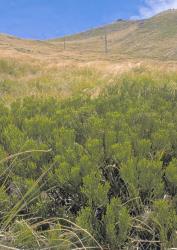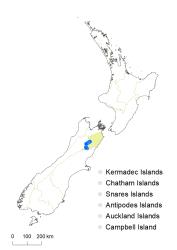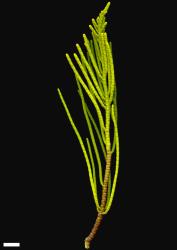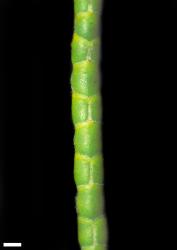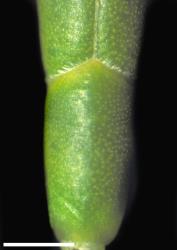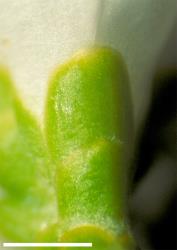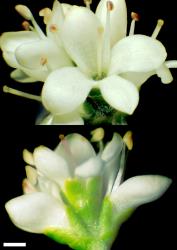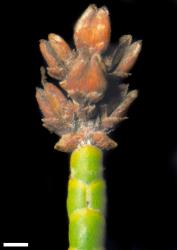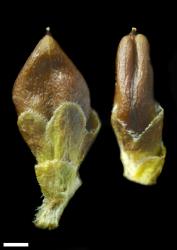- ≡ Hebe salicornioides (Hook.f.) Cockayne & Allan, Trans. New Zealand Inst. 57: 40 (1926)
- ≡ Leonohebe salicornioides (Hook.f.) Heads, Bot. Soc. Otago Newsl. 5: 7 (1987)
Spreading low or bushy whipcord shrub to 1 m tall. Stems ascending to erect, glabrous except for a narrow line of eglandular hairs at the connate leaf bases, or sometimes with mostly bifarious or uniform hairs at base of internodes. Leaf bud indistinct, its outer leaves fully grown, diverging. Leaves opposite-decussate, connate in pairs and encircling stem, appressed but not usually covering the obscure node above, scale-like, coriaceous, broadly deltoid, 0.8–1.5 mm long, 2–4 mm wide, dull or slightly glossy pale to dark green above and beneath; veins not evident, surfaces glabrous; margin shortly ciliate to ciliolate, entire; apex obtuse to rounded; base broad; petiole absent. Inflorescence a terminal spike, 4–16 mm long; flowers crowded, 2–10, all bisexual; bracts opposite-decussate, connate, broadly elliptic to semi-circular; pedicels absent or rarely the lowest to 0.5 mm long, eglandular-hairy all around. Calyx lobes 4–5 (the 5th small, posterior, the anterior pair free or partly to completely fused, obtuse to rounded, 1.5–2.5 mm long, sub-equal, eglandular-ciliate. Corolla 4.0–6.5 mm diameter; tube white, 1.3–1.7 mm long, about = calyx, eglandular-hairy inside; lobes 4, white, erect to recurved, sub-equal, elliptic, 1.8–3.0 mm long, obtuse; nectar guides absent. Stamen filaments white, 2.1–3.8 mm long; anthers white, pink, magenta, or purplish. Style glabrous, 3.2–5.0 mm long. Capsules latiseptate, tapered to acute or narrowly obtuse apex, glabrous, 2.5–4.3 mm long, 1.5–3.0 mm at widest point. Seeds elliptic to oblong, flattened, smooth, pale brown, 0.8–1.2 mm long.
Plants of Veronica salicornioides are similar to V. annulata and V. armstrongii plants, which differ in their shorter internodes and longer leaves. When fresh, V. salicornioides leaves are appressed and give the leafy stems a smooth appearance; however, the leaves separate from the stem a little when the plants are dried.
South Island: Marlborough (in the west from Mt Severn and Tarndale to Lake Tennyson, Mt St Patrick, Mt Charon, and Jack’s Pass).
Material said to be from Otago (Lake Harris, WELT17479, AK 8250; Humboldt Mountains, WELT 17477) has not been included in the distribution (see Bayly & Kellow 2006).
Red tussock grassland, flushes, and slightly boggy sites. Recorded elevations range from 1100 to 1550 m.
Flowers: November–January; fruits: January–February, persisting longer.
2n = 42 (see Bayly & Kellow 2006, as Hebe salicornioides).
Veronica salicornioides is classified in V. subg. Pseudoveronica sect. Hebe and informally in the “Flagriformes” group, also known as “whipcord hebes” (Albach & Meudt 2010; Bayly & Kellow 2006). Four whipcord hebes characterised by fused anterior calyx lobes and exposed but obscure leaf nodes are probably all closely related: V. annulata, V. armstrongii, V. ochracea, and V. salicornioides. These species also differ from the other whipcord hebes in having 2n = 42, 84, or in the case of V. ochracea, 2n = 124.



